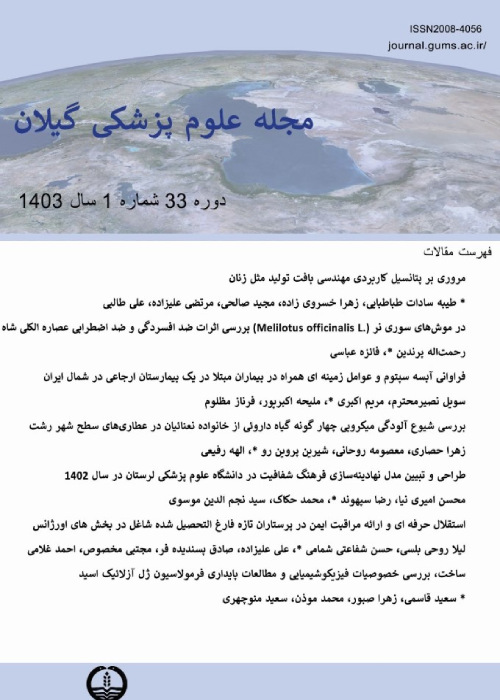Effect of Oxytocin Plus Propranolol on The Success of Labor Augmentation
Author(s):
Abstract:
Introduction
Labor augmentation with intravenous oxytocin is a common method of midwifery in dealing with delivery dystocia and considering the dangers of using high dosage or wrong prescription, the Institute for safe medication has added intravenous administration of oxytocin to the list of high alert medications and recommended creating programs to minimize fetal and maternal injury by reducing the dosage of oxytocin. One method to reduce the dosage of oxytocin is propranolol administration. It has been observed that low dosage of propranolol during the active phase of labor can increase the uterine contractions and cause delivery and reduce the cesarean section significantly without causing maternal and no neonatal complications and cesarean rate. Objective
The comparison between the effects of oxytocin with propranolol and oxytocin with Placebo on the labor augmentation. Materials And Methods
A double-blind randomized clinical trial was performed on 118 nulliparas 38-41 weeks in active phase of labor and failure to progress. Exclusion criteria: Multi-parity with History of surgery on the uterus, malpresentation (non-cephalic), cephalopelvic disproportion(CPD), Fetal distress, macrosomia, polyhydroamnius, IUGR, HTN, Cardiac disease, lung disease, Patients with kidney or liver dysfunction, diabetes, patients prone to hypoglycemia, myasthenia Gravis and Wolf - Parkinson – White. The patients were divided randomly into two groups. The first group was given Oxytocin with propranolol and the second group oxytocin with placebo. Pregnancy outcomes including maternal complications including uterine atonic, complications during labor including hyperstimulation, fetal distress, meconium and placental abruption and neonatal complications including Apgar 1 and 5 minutes of birth, admission in NICU and birth weights in two groups were compared. Results
Duration of the active phase of labor in propranolol group 325.74±71.57 was significantly less than that in the placebo group 406.04±80.32 (p<0.001). Duration of the second stage of labor in propranolol group 23.03±8.31 was significantly less than that in the placebo group 33.83±12.33 (p<0.001). Cesarean section in propranolol group 9(15%) was significantly less than that in the placebo group 15(25.9%) (p<0.001). Failure to progress in propranolol group 2(3.3%) was significantly less than that in the placebo group 5(8.6%) (p<0.023). Conclusion
Propranolol may shorten the duration of the active phase labor and the second stage of it and reduce the dosage of oxytocin and also Cesarean section rate.Keywords:
Language:
Persian
Published:
Journal Of Guilan University Of Medical Sciences, Volume:21 Issue: 82, 2012
Page:
57
magiran.com/p1008542
دانلود و مطالعه متن این مقاله با یکی از روشهای زیر امکان پذیر است:
اشتراک شخصی
با عضویت و پرداخت آنلاین حق اشتراک یکساله به مبلغ 1,390,000ريال میتوانید 70 عنوان مطلب دانلود کنید!
اشتراک سازمانی
به کتابخانه دانشگاه یا محل کار خود پیشنهاد کنید تا اشتراک سازمانی این پایگاه را برای دسترسی نامحدود همه کاربران به متن مطالب تهیه نمایند!
توجه!
- حق عضویت دریافتی صرف حمایت از نشریات عضو و نگهداری، تکمیل و توسعه مگیران میشود.
- پرداخت حق اشتراک و دانلود مقالات اجازه بازنشر آن در سایر رسانههای چاپی و دیجیتال را به کاربر نمیدهد.
دسترسی سراسری کاربران دانشگاه پیام نور!
اعضای هیئت علمی و دانشجویان دانشگاه پیام نور در سراسر کشور، در صورت ثبت نام با ایمیل دانشگاهی، تا پایان فروردین ماه 1403 به مقالات سایت دسترسی خواهند داشت!
In order to view content subscription is required
Personal subscription
Subscribe magiran.com for 70 € euros via PayPal and download 70 articles during a year.
Organization subscription
Please contact us to subscribe your university or library for unlimited access!



